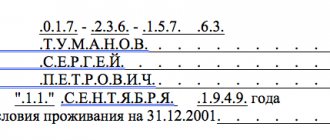Who should be certified
According to the law, all state civil servants are required to undergo certification. The following categories are excluded:
- employees who have worked in their position for less than 1 year;
- employees who have reached the age of 60;
- pregnant women;
- workers on maternity leave, as well as on parental leave until the child reaches the age of three;
- employees who passed certification less than one year ago;
- employees holding positions of managers, assistants and advisers with whom a fixed-term employment contract has been concluded (except for positions appointed by the president or the government).
The purpose of certification of a civil servant
What is the purpose of certification of a civil servant? The main purpose of certification of a state civil servant is to determine the suitability of a state civil service employee for his position based on his professional activities. In addition, knowledge assessment helps to timely identify promising specialists, determine their potential or the need to send them for additional training in order to improve their skills (or retraining). In turn, state civil servants who show negative results during certification may be demoted or even, under certain circumstances, relieved of their positions and dismissed from the state civil service.
Certification of employees for suitability for the position held in 2020
Certification of employees for suitability for the position held - 2020 is carried out in accordance with the norms of the law “On Amendments to the Labor Code of the Russian Federation...” dated 05/02/2015 No. 122-FZ, which entered into force on 07/01/2016.
These standards establish the need to apply professional standards when determining employee qualification requirements. This primarily concerns medical workers, auditors, contract workers, i.e. those whose activities are subject to certain qualification requirements.
Read more about this in our article .
Professional standards and qualifications are discussed in detail in Art. 195.1 Labor Code of the Russian Federation. Determining the employee’s skill level is the main purpose of certification. And to establish this level, from July 2016, only professional standards should be used.
Frequency of civil servant certification
How often is certification of a civil servant carried out?
There are two types of certification:
- regular - held once every three years;
- extraordinary - can be carried out before the expiration of a three-year period from the date of the last assessment.
Extraordinary certification of civil servants may be carried out by agreement of the parties, taking into account the annual report on the results of the employee’s professional activities. It can also be carried out at the initiative of the employer due to the need to reduce staffing or change wage conditions.
Goals and types of certification
Several reasons for extraordinary certification.
Types of certification include:
- Planned, which is carried out within the time limits established by a local act at the enterprise;
- Unscheduled or ahead of schedule, carried out after the lapse of time.
An early employee certification commission may be caused by the following number of reasons:
- if the employee is subject to promotion to a higher vacancy;
- failure to perform official duties due to the incompetence of the employee.
The last reason for extraordinary certification may be the following:
- The desire of the employee himself to engage in other job responsibilities that exceed the status of the position held;
- On the initiative of the immediate supervisor, who has the opinion that this employee cannot cope with the job or simply was not subject to certification due to the fact that he had not worked in the position for less than a year;
- If the evaluation of the certification commission was assigned “conditionally”.
Order of conduct
Details of the organization and conduct of certification in government agencies must be developed and enshrined in a special regulatory act. It can be called differently: regulations, order, regulations (in our article we will use the term “Regulations”). But its essence remains the same - it contains complete information about the certification schedule, the certification commission, the necessary documents, the list of state civil servants subject to certification, and the procedure itself.
Certifying commission
The procedure and rules for forming the certification commission are described in detail in Art. 48 Federal Law No. 79-FZ “On the State Civil Service of the Russian Federation”. The certification commission must be formed in such a way that there are no conflicts of interest among its members that could affect the making of decisions. In addition, the specifics of the employees' job responsibilities must be taken into account, so if necessary, several commissions can be created. For example, certification of state civil servants who use information containing state secrets in their work is carried out separately. At the same time, members of the certification commission must have the appropriate clearance.
The commission must consist of a chairman, deputy chairman, secretary and members of the commission. Its members can be: a representative of the employer, a representative of the federal government agency for civil service management, representatives of educational organizations as independent experts. The number of the latter must be at least ¼ of the total number of members. All members of the certification commission have equal rights when making decisions. If a member of the certification commission is himself a state civil servant who is required to undergo this procedure, he is temporarily removed from the commission.
Stages
The procedure for employee certification is as follows:
- Initially, authorized persons develop an assessment schedule.
- The employee receives notification of future personnel certification at the enterprise in writing (no later than two months in advance). The subordinate must sign the order to continue the preparation process.
- After drawing up the order and its certification, you can begin to create an expert group that will carry out the assessment. In most cases, the commission consists of qualified specialists, as well as trade union members.
Important! A manager who directly manages the work of a specific subordinate cannot be a member of the commission. This condition (especially in small organizations without branches) is very difficult to fulfill, so companies usually create several commissions.
- Next comes the preparation of certification forms, as well as characteristics. The latter will act as an auxiliary tool for the commission if its members are not familiar with the persons being certified. The form of this document is approved by a local act.
- Before conducting certification, the commission enters data into the protocol, where all information about the employee’s qualifications must be posted in advance. If its confirmation requires the completion of written tasks, then they are drawn up on a separate form and serve as an addition to the protocol. If any additional information appears about the employee’s professional suitability directly during certification, members of the expert group can either immediately begin to consider it or pause to process additional data. This must be noted in the protocol.
- After hearing and discussing all participants, highly qualified specialists proceed to vote, and in some cases, employees are also allowed to be present during the announcement of the results.
- The last stage of certification is the processing of the protocol with the results by the manager and making personnel decisions (completing advanced training courses, transferring to another position or terminating the employment relationship). A corresponding decree is issued about all personnel changes that are the result of certification of social workers (an example of it can be downloaded on the Internet).
Certification schedule
The certification schedule for state civil servants is drawn up annually and approved by the employer. Moreover, each of those being certified must be familiar with this document no later than a month before the test. The schedule must contain the following information:
- name of the state structure, departments in which certification is carried out;
- list of state civil servants subject to certification;
- date, time and place of certification;
- date of submission of the necessary documents to the commission;
- a list of managers responsible for their provision.
Certification schedule form
Preparation of documents
For absolutely every civil servant subject to certification, a package of documents is prepared, which must be contained in the certification regulations. Typically it includes:
- certification sheet with the results of the previous certification;
- a review of the performance by a state civil servant of his duties, signed by managers and the employee himself;
- progress reports, etc.
A review of the civil servant’s performance of his duties must be prepared and submitted to the certification commission no later than two weeks before the date of certification, which is stated in the Regulations on the certification of state civil servants of the Russian Federation.
Form of certification sheet
Feedback form about the certified employee
The Regulations may stipulate the forms of these documents, and also assign the responsibility for their preparation to any employee.
How to get objective results of employee certification - 3 useful tips
Objectivity is an important component of personnel certification.
Our advice will help you avoid problems in this matter.
Tip 1: Expand your lineup as much as possible.
As I already wrote, the number of participants in the certification commission is not limited. Include as many specialists as necessary to carry out the procedure efficiently.
The main condition: all members of the commission must enjoy authority and be competent in the professional specializations of those being certified. Such a composition will create more trust and reduce the risk of conflicts.
Example
During the certification process at Albatros LLC, a conflict situation arose when assessing the professional competencies of system administrator Fedor Kuzkin.
The commission decided to downgrade Kuzkina's category. Fedor wrote a complaint to the director of the company, in which he drew attention to the incompetence of the commission members in matters of system administration.
Indeed, the commission did not have a single specialist in this area, and, therefore, they could not properly assess the professional qualities of system administrator Fedor.
The director of Albatross LLC agreed with Kuzkin’s arguments and the recommendations of the certification commission were not accepted.
Tip 2. Conduct certification only in the presence of the employee
Despite the fact that the law provides for cases of certification in the absence of an employee (unreasonable absence, unwillingness to undergo an examination), it is better to conduct it in his presence.
This way you will reduce the risk of conflict and challenging the outcome on the part of the employee being evaluated.
Tip 3. Trust third-party companies to carry out certification
If you want to get really high-quality certification results and get rid of headaches about this, I recommend ordering this event from specialized companies.
Such companies can be entrusted not only with personnel certification, but also, for example, with a special assessment of working conditions (SOUT).
Need more information on a topic? Watch the video!
https://youtu.be/oiK3YkWyTw4
Certification procedure
At least a week before the planned certification, the personnel service employee is obliged to familiarize each state civil servant subject to certification with a review of the performance of his duties prepared for transmission to the certification commission. In case of disagreement with the information provided, the civil servant has the right to independently prepare additional documents confirming his successful activities in the state civil service.
During the knowledge test, the person being certified is invited to a specially designated room to the certification commission, which examines the documents provided, and can also conduct tests, surveys, interviews and other procedures to determine the qualification level of a civil servant. All these details must be fixed in the Regulations.
If a civil servant does not appear, then, depending on whether the reason for the absence was valid or not, the event may be postponed, held in absentia, or a disciplinary sanction may be imposed on the employee.
Options for decisions made
It is recommended that the wording, procedure and timing for announcing the decisions of the certification commission be enshrined in the Regulations. The decisions themselves may have the following wording:
- corresponds to the position held in the civil service;
- corresponds to the position held in the civil service and is recommended for inclusion in the personnel reserve to fill a vacant position in the civil service in the order of career advancement;
- corresponds to the position held in the civil service, subject to successful completion of additional professional education;
- does not correspond to the position held in the civil service.
All results are entered into the minutes of the commission meeting. When making a decision, it is recommended to justify it and propose measures to improve the certification results.
The certification sheet is provided to the civil servant for review against signature and is then stored in his personal file along with feedback on the performance of duties and a work report.
No later than 7 days after the certification of state civil servants, its results must be transferred to the representative of the employer, who, in turn, within 30 days issues a legal act of the state body with decisions regarding certified civil servants. Solutions may be as follows:
- on the inclusion of a civil servant in the personnel reserve to fill a vacant civil service position in the order of job growth;
- on sending a civil servant for professional retraining or advanced training;
- on the demotion of a civil servant to a civil service position.
According to labor legislation, it is impossible to dismiss an employee from the civil service based on the results of certification. But if he refuses to be demoted, upgraded or retrained, then the employer has the right to remove the civil servant from his position and dismiss him from the civil service. (Clause 17, Article 48 of Federal Law No. 79-FZ).
Form of minutes of the commission meeting
What to pay attention to when drawing up the Regulations on employee certification?
Part 2 Art. 81 of the Labor Code of the Russian Federation states that the certification procedure is established, among other things, by local regulations adopted taking into account the opinion of the representative body of workers. Since the provision on certification of workers is a local regulatory act, when developing it, it is necessary to take into account the opinion of the trade union (if there is one) in the manner prescribed by Art. 373 Labor Code of the Russian Federation.
First of all, the Regulations indicate the goals and objectives of certification, for example:
— change in organizational structure;
— establishing the need for advanced training of employees;
— changing the system of remuneration and bonuses.
Next, it is reported which categories of personnel are subject to certification. There is no such list in the Labor Code; it needs to be fixed in a local regulatory act. Please remember that Resolution No. 470/267 establishes a number of restrictions in relation to some workers, in particular, those who do not undergo regular certification:
- persons who have worked in their position for less than one year;
- pregnant women;
- women with children under one year of age.
This list can be supplemented to include employees with whom a fixed-term employment contract has been concluded for a certain period (for example, up to one year), if certification is carried out once every few years, or who are on maternity leave, etc. In this case certification can be carried out at the end of such leave.
What to do with employees who also hold multiple positions? In this case, it is advisable to indicate that persons hired for internal part-time work undergo certification both at their main place of work and part-time. For example, if an employee is both a legal adviser and a clerk, he will be certified for both positions.
Another category of workers that you need to pay attention to are young professionals. Resolution No. 470/267 clarifies that they are not subject to certification during the period of compulsory work for their intended purpose after graduation.
Since there is almost no such practice now, the employer decides the issue of certification of yesterday’s students at his own discretion.
The Regulations also need to establish the timing of certification. Decree N 470/267 recommends that it be carried out every three or five years. However, other deadlines can be set, for example, annual certification or no more than once every two years, but not less than once every four years.
Note.
Depending on the timing of the certification, it can be regular (carried out at certain intervals (once every six months or once a year, three, five years, etc.), for example, to establish the compliance of the employee’s qualifications with the work performed) and extraordinary (when identifying the fact of manufacturing defective products, frequent complaints about the behavior of a specialist, or when the head of a department submits a memo to the certification commission about the employee’s non-compliance with the requirements for the position he occupies).
Taking into account industry specifics, reasons for early certification may be established. Thus, in the above-mentioned provision on the certification of persons transporting passengers and cargo, it is determined that early certification is carried out when gross violations of the rules and regulations governing the safe operation of vehicles are detected, or in the event of transport accidents with serious consequences.
In the Regulations on the certification of employees of the organization, it is necessary to provide a section on the certification commission, which indicates its composition and distributes powers between its members. Usually the commission includes a chairman, deputy chairman, secretary, and in accordance with the requirements of Art. 82 of the Labor Code of the Russian Federation must be included in the composition of the representative of the trade union organization (if there is one). In addition to these persons, the commission may include:
— experts from among highly qualified workers;
— heads of structural divisions;
- independent experts.
It is also advisable to indicate in the Regulations the number of commission members (including experts, whose presence is mandatory for the certification results to be recognized as legitimate).
If the organization has branches, representative offices or other separate divisions, we recommend that certification commissions be created at the location of these divisions, otherwise commission members will have to be sent on business trips, and this may negatively affect the production process and increase financial costs. Therefore, if there are remote structural divisions, the Regulations on Certification should explain how a commission is created in a branch (representative office), provide for the rights of officials to form such a commission, the procedure for transmitting final information, etc.
Note!
Since members of the certification commission may also be subject to certification, the Regulations must include a condition that the employee is exempt from membership in the commission for the period of his certification or does not participate in voting.
Note that in this section it is possible to regulate in more detail the decision-making process on certification. For example, determine the type of voting (open, closed, in the presence of an employee, etc.), who will sign the minutes of the commission meeting, within what time frame the commission must submit the results of certification to the head of the organization to make a final decision on a specific employee, the number of votes of the commission members, at which the employee is considered to have successfully passed the certification (for example, 2/3 or half of the commission members).
Next, the regulations need to specify all stages of preparation for certification. The most important thing at this stage is to determine those responsible for the preparation and transfer of materials to the commission, that is, documentation support, persons (structural unit). They:
— prepare lists of employees subject to certification;
— they will remind the heads of structural divisions about the need to provide a reference for the person being certified (we recommend clarifying what information the reference should contain);
- will collect the materials necessary for certification related to the employee’s work activity (reviews, characteristics, copies of complaints or positive reviews, reports on the work done, marriage certificates, copies of orders on promotion and disciplinary action, etc.);
— draw up a schedule for certification;
— will prepare draft orders, for example, on forming the composition of the certification commission or on setting deadlines for familiarizing employees with the results of certification.
Let us separately dwell on the issue of drawing up a schedule for certification. Schedules can be drawn up both for the entire organization as a whole, and for individual divisions, as well as for categories of positions (managerial staff, specialists, workers, technical performers). In the appendix to the Regulations, you can approve the form of the schedule, which will be used in all divisions of the organization.
It is imperative to describe the procedure for communicating information about the timing of certification to members of the certification commission and employees subject to certification.
It is also necessary to determine the timing of approval of the certification schedule and the procedure for making changes to it in the presence of certain circumstances (illness, business trip, etc.). The head of the organization (authorized person) can directly approve the schedule or issue a separate document (order, instruction) about this. It is advisable to establish the method for approving the schedule in the Regulations.
But what if, after the certification schedule has been approved, it becomes necessary to reschedule it, for example, due to a production accident or other emergency? We recommend that the Regulations on Certification of Employees note the possibility of its transfer and determine how this is done (for example, new certification periods are determined by order of the employer).
The main and, perhaps, the most difficult to develop section is the section of the Regulations, which sets out the criteria for assessing the level of qualifications of workers. To establish these criteria, the first step is to use the Qualification Directory of Positions for Managers, Specialists and Other Employees, approved by Resolution of the Ministry of Labor of the Russian Federation of August 21, 1998 N 37, and unified qualification directories by industry. The qualification characteristics given in them are taken as the standard and the employee is assessed based on it.
If different evaluation criteria are established for different categories of employees in an organization (separately for workers, managers, specialists), it is advisable to formalize this in the form of an appendix.
Note!
Employees subject to certification must be familiar with the evaluation criteria in advance, before the certification procedure.
When establishing evaluation criteria, the complexity of the work performed, the variety of tasks, the degree of responsibility and effectiveness, as well as the responsibilities assigned to the employee are taken into account. Sometimes it is necessary to take into account the provisions of other regulatory legal acts that regulate the certification procedure for certain categories of workers: they may also contain certain criteria.
Remember that if the person being certified was asked questions that are not related to the work he performs, incorrect answers to them cannot serve as a basis for recognizing the employee as unsuitable for the position held.
Let us note that it is possible to determine the suitability of qualifications for the work performed only if the functions performed by the employee are described as clearly as possible in the employment contract. If an employee is found unsuitable for his position, and his job responsibilities are not documented, disputes may arise.
For your information.
In accordance with paragraphs 700, 701 of the List of standard management archival documents generated in the process of activities of state bodies, local governments and organizations, indicating storage periods, documents (tests, questionnaires, questionnaires) to determine (assessment) the professional qualities and capabilities of employees must be stored permanently.
The procedure for conducting certification must be regulated clearly and in detail. Here you can describe:
— the procedure for keeping minutes of the meeting of the certification commission, its form, the procedure for approving the minutes and familiarizing employees with the decision of the commission. At each meeting of the commission, one protocol is kept, in which data on each certified person is entered;
— the procedure for inviting an employee to undergo certification;
— actions of the commission in the event of an employee’s failure to appear for certification;
— a list of reasons for which omission of certification is considered disrespectful, and responsibility for such omission;
- the period during which the certified person must inform the certification commission or the department responsible for preparing the certification of failure to appear for certification;
— the procedure for discussing materials submitted to the certification commission and test results.
Based on the results of the certification, the commission members make a decision. It is advisable to fix the wording of such decisions in the Regulations. They may be as follows:
— the person being certified corresponds to the position held;
— corresponds to the position held and is recommended for inclusion in the established order in the personnel reserve;
— corresponds to the position held, subject to successful completion of professional retraining or advanced training;
- does not correspond to the position held.
After making a decision, the commission records it in the minutes. As a rule, the results of certification are announced to employees immediately after the voting results are summed up.
The regulations need to fix the period within which the employer must comply with the recommendations of the certification commission, that is, a specific period of time is determined for the employer to make a final decision. Usually this is a month or two.
For example, if the commission decides on the suitability of the position held, subject to successful completion of advanced training, the manager must, within a specified period:
— send a specific employee to advanced training courses;
- offer another job that matches your qualifications.
When making a decision based on the results of certification, the manager should remember that there are categories of personnel who cannot be dismissed due to inconsistency with the position held or the work performed, namely (Article 261 of the Labor Code of the Russian Federation):
- pregnant women;
- women with children under three years of age;
- single mothers raising a child under the age of 14 (a disabled child under the age of 18);
- other persons raising a child under 14 years of age (disabled child under 18 years of age) without a mother.
Often, the Regulations on Personnel Certification include disciplinary sanctions among the measures of influence on employees. This is unacceptable, since inadequacy for the position held does not imply the employee’s fault for lack of sufficient qualifications, and if a dispute arises and is considered in court, the employer’s actions to bring employees to disciplinary liability will be declared unlawful, and the provisions of the local regulatory act on personnel certification will be invalid (Part 4 of Article 8 of the Labor Code of the Russian Federation).
In addition to the measures that can be taken in accordance with the decision of the commission, the Regulations should indicate the employee’s right to appeal its results.










